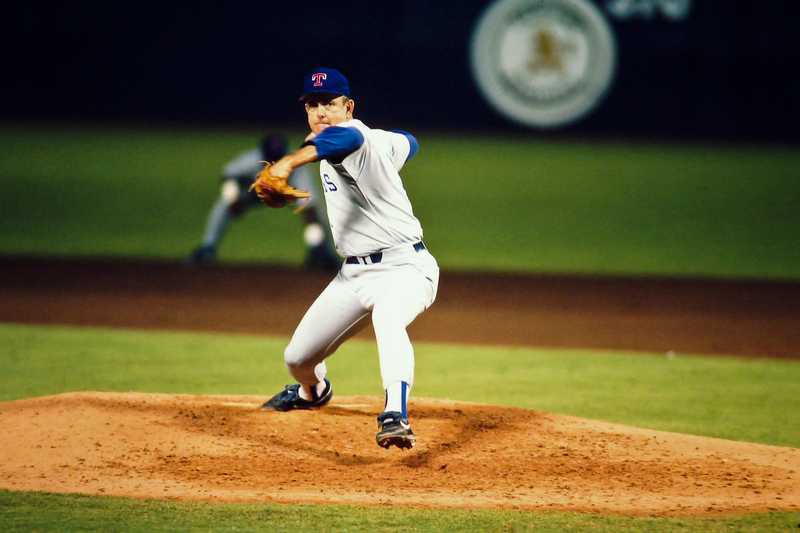Last updated on October 27th, 2023 at 06:19 am
A quality start in baseball refers to a starting pitcher who throws at least six innings and gave up three or fewer runs in their outing. However, earning a quality start does not mean you will get the win for a game. Perhaps the game is tied when you leave after the six, or maybe your team hasn’t scored any runs after you give up one run, and you lose the game 1-0. While the non-win or loss looks terrible on the pitcher, the quality start metric helps explain that the pitcher did their job when they were on the mound.
Who Coined the Phrase “Quality Start” in Baseball?
The phrase “quality start” comes from John Lowe, a sportswriter for the Philadelphia Inquirer in 1985. As the years have gone by, organizations and players expand that phrase to explain different scenarios. For example, Nolan Ryan uses the term “High-Quality Start” to represent a pitcher who pitches seven innings and gives up less than three runs. Another phrase you may hear from the radio and TV announcers is a tough-loss, which means a pitcher lost the game even though they got the quality start.
How is a Quality Start Different from a Complete Game?
A quality start differs from a complete game due to the innings pitched, but a person can achieve both stats in theory. Since a quality start needs to be at least six innings and less than four runs, a pitcher could go all nine innings and give up less than four runs too. If a pitcher can go all nine innings and give up less than four runs, they receive a quality start and complete game.
Who is the All-Time Quality Start Leader?
According to Wikipedia as of 2023, Don Sutton leads all MLB pitchers with 483 quality starts. After him, Nolan Ryan is in second place with 481. Check out the full list from Wikipedia to see more of their stats via wins and losses along with their number of quality performances.
- Don Sutton (483)
- Nolan Ryan (481)
- Greg Maddux (480)
- Roger Clemens (465)
- Tom Seaver (454)
- Gaylord Perry (453)
- Steve Carlton (447)
- Phil Niekro (442)
- Tom Glavine (436)
- Tommy John (431)
A Change in Pitching in Recent Years
Sabermetrics and mathematicians now run most of the decision-making for Minor League and Major League Baseball organizations. Statistics and projections lead to teams managing the game in a radically new way. Teams today tend to remove pitchers earlier from games for a few reasons.
First, data implies that baseball players who see the same starting pitcher on their third visit yield a higher average and OPS. Second, if the pitcher pitches over 100 pitches in a game, hitters tend to hit better off them. Third, teams look for quality outs instead of long outings during baseball games. The rise in groups using a baseball opener (reliever who starts the game) suggests using your best pitcher no matter what to get an out. Finally, teams don’t want their starting pitchers to get hurt due to the financial investment, so they take them out to prevent injuries.
With these four examples above, you will see fewer quality starts in the game. Fantrax HQ has a visual that shows a downward trend in innings per game pitched and pitches thrown per game. In 2015, you had 5.81 innings pitcher per game, but 2020 saw that number drop down to 4.8. With this trend, it is safe to conclude that the league average of innings pitched will continue declining year over year.
Is the Quality Start Stat Over-Rated Now?
With the visual above from FanTrax HQ illustrating the decline in innings pitched, you may wonder if the quality start stat is overrated. The answer to that question is that statistics help drive a strategy but don’t need to be the above all be all story. Teams can study many stats like strikeouts, walks, WHIP, wins, earned run average, losses, and more to measure how effective that pitcher is for their team.
Take the Tampa Bay Rays as an example of an organization changing the game for pitching. The Rays were one of the first team to introduce the opener strategy, which was odd since every other team had a starting pitcher start a game. Over the years, more groups began opting for a similar approach using an opener. Since the data suggests that winning at-bats early in the game can lead more wins, teams are using the opener often.
Also, it is worth noting that there is debate if the quality start is overrated. For example, if a pitcher consistently went six innings and gave up three runs, they would have an ERA of 4.5, which is high. During the 2022 MLB season, the average ERA for all teams was a 3.96, which means that a quality start pitcher is actually worse than the league average.
Conclusion: What is a Quality Start in Baseball?
In summary, a quality start represents that a pitcher went at least six innings and gave up three or less runs. However, it doesn’t mean that they will get the win for the game even with their quality start.
Similar Posts
How Many Innings in College Baseball?
What is Tipping Pitches in Baseball?
What is the Triple Crown in Baseball?
What Does Bush League Mean in Baseball?
Greg Kristan, owner of The Stadium Reviews, LLC and TM Blast, LLC, brings his extensive experience visiting over half of the MLB ballparks, along with numerous MLS, NHL, NBA, and NFL venues, to provide in-depth coverage on the bag policy, food options, and parking. He has also been interviewed about his experiences on several sports podcasts.







